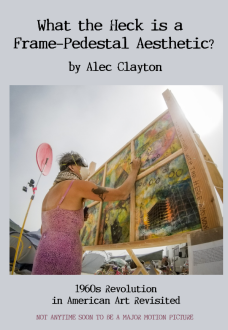Becky Hendrick, author of Getting It: A Guide to Understanding and Appreciating Art
A half-century doesn’t diminish the value of What the Heck’s lessons, beautifully realized and written.


Jennifer Olson, Art Historian and Gallery Director, Tacoma (WA) Community College
Alec Clayton’s refusal to hold an exhibition for his Master of Art degree from East Tennessee State University was a ground-breaking event in 1970. Now fifty-years later with a rich career as an artist, art critic, and novelist, Clayton revisits his master’s thesis, What the Heck is a Frame-Pedestal Aesthetic?, a critical essay about the contributions that Cage, Duchamp, Johnson, Kaprow, Pollock, Warhol, and others made to move art forward through the use of new concepts, experiences, formats, materials, and spaces for art.
I especially enjoyed learning about his collaboration in a mail art piece with Richard C. and Ray Johnson.

Amazon Customer
Collage and social change in the 20th Century
In 1970 Alec Clayton looked around him and saw that constraints on artists in their choice of media and subject matter were falling away. In his art school MA thesis he accounted for this in two ways: Innovations by artists over the last century had loosened the bounds on artists and the social upheaval the 1960s provided a powerful incentive for artists to respond to the changes in society. He has now republished his thesis as a monograph “What the Heck is a Frame Pedestal-Aesthetic?” with a few additional comments and some added illustrations, notably by the collagists Ray Johnson and Richard C.
Clayton believes that artists in 1970 and beyond are no longer bound by previous constraints of media and style thanks to the innovations Picasso and Braque developed in Cubism as well as the new sense of freedom pursued both by those involved in DADA and the Surrealists. Jackson Pollack and William de Kooning, sweeping away any previous constraints, are the two Abstract Expressionists that interest him most. Pop Art’s use of advertising materials, comics and other materials of the day to day signal for Clayton a turning away from ideas about beauty in art toward a social critique.
From his viewpoint in 1970, the turmoil of social change seems to suggest that artists are unlikely to return to an aesthetic of beauty and will be energized by having no limits on how they might convey their ideas.
He makes a convincing argument for John Cage as the example of an artist achieving success through embracing new modes of expression. In comments he added for this publication he also mentions Earth Artist Andy Goldsworthy, Richard Long and Robert Smithson as artists responding with new strategies to the world around them.
One mode of expression that Clayton tracks through 20th century art history is collage. He begins with Picasso and Braque’s use of collage as a significant element in Cubism and mentions de Kooning’s use of a portion of a commercial image in his work. Pop Art for Clayton is all about collage as a method and a style. Collage often means using found materials and Clayton believes that practice brings energy to the artist’s expression. As I read, it occurred to me that found materials are the thread that connects Earth Art, Pop Art and Cubism. It is of course also an important consideration for John Cage.
I have a great enthusiasm for the collagists Richard C and Ray Johnson and I was pleased to learn that Clayton recognizes them as the inspiration for this study. He indicates his indebtedness by reproducing work by Richard C (one as recent as 2018) and Ray Johnson as the book’s illustrations. He also includes undated collages of his own. They show the influence of Richard C, Ray Johnson, Tom Wesslemann and Mel Ramos.

